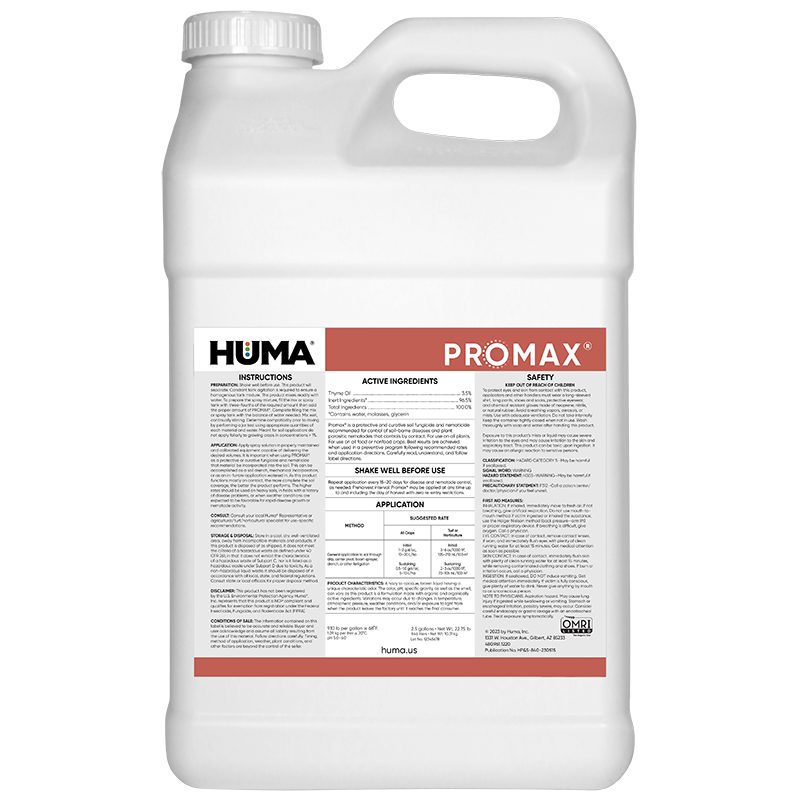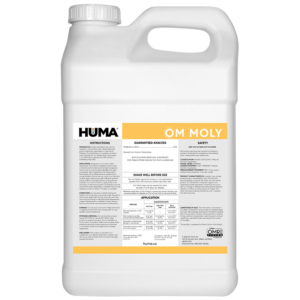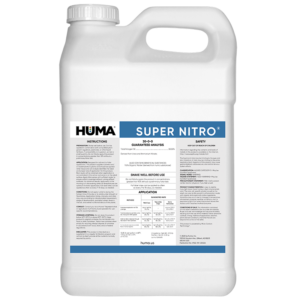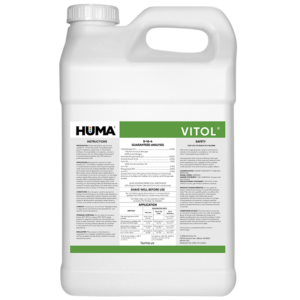PROMAX®
Benefits of Use:
- Inhibits nematode activity
- Provides excellent control of fungal diseases in soils
- Activates natural defense mechanisms in plants
- Safe for crops, humans, and the environment
- Fungicidal effect against all types of fungal spores
- Product’s natural chemistry has no documented cross-resistance
- Cost-effective performance
- Fast-acting upon contact
- Restricted Entry Interval (REI): 0 days
- Pre-Harvest Interval (PHI): 0 days
FAQs
Related Videos
Huma Crop Protection
Are pests eating up your profits? Do you need crop protection that is as safe as it is effective? Soil-applied Promax and foliar-applied Proud 3 are highly effective zero-residue products with not buffer zero
Learn More
Huma Promax: Crop Protection Product
A soil fungicide and nematicide that eliminates pests and soil-borne disease naturally. OMRI-listed organic pesticide is soil applied to kill soil pathogens and nematodes on contact. Zero residue, no buffer zone, and no re-entry
Learn More
Chili Farmer Performs Field Trials with Organic Pesticide
Chili Farmer Chip Spear of Luna County New Mexico runs field trials using Huma Gro Promax biopesticide. OMRI-listed Promax effectively treats nematodes and soil disease and is safe enough to use throughout the growing season,
Learn More
Related Products
Related Case Studies
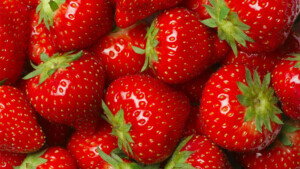
Huma® Promax® and Zap® Decrease Charcoal Rot in Florida Strawberry, With Increased Yield and ROI of 10:1
Background Charcoal rot, caused by the soil-borne pathogen Macrophomina phaseolina, can be a significant threat to strawberry production. Two Huma® products, Promax® and Zap®, had previously been shown to be successful in managing soil-borne diseases in strawberries. Objectives The primary objectives of this study were to assess the efficacy of Promax® and Zap® in reducing

Huma® Ultra-Precision™ Blend Plus Root Dip Increases Strawberry Yields 30%
Objective The purpose of this research project was to evaluate how a special blend of fertilizer solution and a root dip made of Huma® products with Micro Carbon Technology® affect strawberry yield when compared with a control program of grower’s standard fertilizer and a competitor root dip product. Materials & Methods Strawberry cultivar San Andreas

Huma® Nutrient and Fumigation Replacement Program Increases Strawberry Yields
Objective This field trial assessed the effects on strawberry yields of replacing field fumigation with periodic applications of Huma® Promax® and Zap® and replacing a grower’s standard fertilizer program with irrigation-applied Ultra-Precision™ blended liquid Huma® crop nutrition products. Materials & Methods This trial was conducted in Arroyo Grande, Calif., using Portola strawberries planted in 40’
Related Blog Posts

California Approves First 8 Fertilgold Products for CDFA-OIM Status
The California Department of Food & Agriculture (CDFA) has registered 8 Fertilgold® Organics products as Organic Input Materials (OIM) that can be sold in the state. Those products include the following: secondary macronutrients Fertilgold® Ca and Fertilgold® Mg, and micronutrients Fertilgold® B, Fertilgold® Co, Fertilgold® Mo, Fertilgold® MoN, Fertilgold® Zn, and Fertilgold® Micros I (which
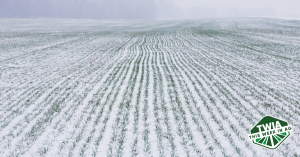
This Week In Ag #95
Fans of the animated Christmas classic “The Year Without a Santa Claus” will undoubtedly recall Heat Miser and Snow Miser, the bickering siblings who controlled weather patterns. Their outright refusal to cooperate with one another forced Mrs. Claus to go over their heads and see Mother Nature when she desperately needed snow to fall in

Field Trial: Promax® and Zap® Reduce Nematodes, Increase Yields for Green Chiles
A recent field trial on green chile peppers has concluded that Promax® and Zap® treatment is noticeably effective in lowering the parasitic nematode population while improving the beneficial microbe population. This positive effect on the soil biology boosted the yield of green chile peppers and resulted in an increased profit for the farmer.

